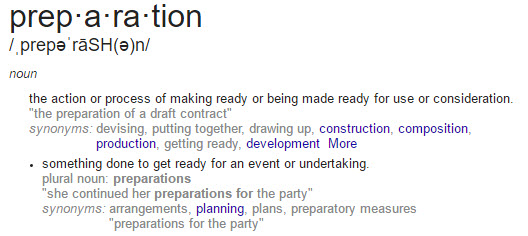I have spoken to people that believe that planning and goal making are not really for them. They believe that if they plan, they will be constricted, and if they make goals, they will just set themselves up for failure. I guess that is one way to look at it, and I can understand the latter part of that. I admit that I don’t know everyone in the world (not even close), but I have never heard a successful person say something like that. There are people that seem to have a lot of luck in life, but for the rest of us, we need to prepare ourselves for success, and we need to plan for it. Graveyards are riddled with good intentions, lost hopes, failed dreams, and plenty of regrets.

Preparation, Prepare, Preparing
Preparation is a part of life. We grow-up with it in everything we do. Washing our hands before dinner, getting dressed to go somewhere, brushing our teeth before bed, and a million other mundane tasks – ingrain in us that “preparation” is an important part of life. Somewhere in life, many people get tired of preparing, perhaps they failed at achieving some goals, perhaps they got sick of chasing the dream. When it comes to personal or organizational success, we always have to be preparing. How do we prepare:
- Read books that improve our knowledge and skills
- Hire a coach to improve accountability and learn new methods
- Be a part of a mastermind group to improve accountability, collaboration, and meet new people
- Attend social events and conferences to learn and increase our network
- etc… etc…
Everyone is preparing for something, are you preparing for success, or preparing for failure? If you don’t prepare, its unlikely you’ll make it to where ever it is you want to go, in fact you may not ever start.
Plan, Planning
I have been talking about planning all week in the posts I’ve shared. We can prepare all the time, by reading books, getting a coach, but hopefully all that is a means to an end, an end that brings you success, happiness, security, or what ever it is you are after. Sitting down and making “a decision about what one is going to do,” and then designing a road-map to get to that destination, will bring clarity.
- Clarity about what is more important
- Clarity about who is more important
- Clarity about your purpose
- etc… etc…
If you don’t plan, you don’t know where you’re going or how you are going to get there. Whether it is organizational objectives and plans, or personal objectives and plans, they both bring greater purpose and action. Don’t be the kind of person that reads lots of books and is always preparing for something, but never sits down and makes a plan to obtain that something, and use those skills. Graveyards are riddled with smart, brilliant people, that didn’t plan or execute.
What are you going to do to start preparing and planning? Share your thoughts in the comments section.


 I have seen a lot of failed strategies with companies, as I am sure you have as well. These strategies come in many shapes and sizes. Sometimes they are an idea on the back of a napkin. Sometimes they are a copy or slight modification of a competitor’s strategy, sometimes they are a fancy PowerPoint full of charts with hockey stick curves. The same is true for the personal strategies to get us where we want to go in life.
I have seen a lot of failed strategies with companies, as I am sure you have as well. These strategies come in many shapes and sizes. Sometimes they are an idea on the back of a napkin. Sometimes they are a copy or slight modification of a competitor’s strategy, sometimes they are a fancy PowerPoint full of charts with hockey stick curves. The same is true for the personal strategies to get us where we want to go in life. Many people have a hard time with planning, or do not realize they do… It is easy to have an idea in your head and then stare at a blank piece of paper trying to figure out where to start. This is true for personal plans and also any kind of business plans, be it Annual Plans, Quarterly Plans, etc… On that same token I have seen people who think they are good at planning, and end up putting lots of notes into a document that are cryptic and hard to figure out.
Many people have a hard time with planning, or do not realize they do… It is easy to have an idea in your head and then stare at a blank piece of paper trying to figure out where to start. This is true for personal plans and also any kind of business plans, be it Annual Plans, Quarterly Plans, etc… On that same token I have seen people who think they are good at planning, and end up putting lots of notes into a document that are cryptic and hard to figure out. Silos are Ugly! Some time ago I worked with an organization that offered telecommunication services (60% of revenue) as well as IT services (40% of revenue). The two service types were very complimentary to each other, and each had the potential to boost and feed revenues and profits on both sides of the company. Unfortunately, there was a big frustrating and annoying problem that caused contention, fighting of resources, hurt feelings, and lack of innovation. That problem was a big wall, which in the business world, we call… silos!
Silos are Ugly! Some time ago I worked with an organization that offered telecommunication services (60% of revenue) as well as IT services (40% of revenue). The two service types were very complimentary to each other, and each had the potential to boost and feed revenues and profits on both sides of the company. Unfortunately, there was a big frustrating and annoying problem that caused contention, fighting of resources, hurt feelings, and lack of innovation. That problem was a big wall, which in the business world, we call… silos! As we passed the half year mark I reviewed my long-term and annual goals and realized that if I wanted to achieve some of my goals, I needed to really help others achieve their goals. I have been using the Ultimate Annual Success Plan this year and it has been enormously helpful in assisting me to achieve my goals. I decided that it was time to give back to my subscribers and help make the second half of this year – your best year ever.
As we passed the half year mark I reviewed my long-term and annual goals and realized that if I wanted to achieve some of my goals, I needed to really help others achieve their goals. I have been using the Ultimate Annual Success Plan this year and it has been enormously helpful in assisting me to achieve my goals. I decided that it was time to give back to my subscribers and help make the second half of this year – your best year ever. “Everything is theoretically impossible, until it is done.” An American science-fiction author, Robert A. Heinlein, is responsible for capturing the essence of execution in these eight simple words.
“Everything is theoretically impossible, until it is done.” An American science-fiction author, Robert A. Heinlein, is responsible for capturing the essence of execution in these eight simple words.
 I usually refrain from posting articles about lessons learned from disasters, just out of respect for the events. This week though, a valuable leadership lesson was displayed to me and the words “put-out or shut-up” is what cycles through my mind.
I usually refrain from posting articles about lessons learned from disasters, just out of respect for the events. This week though, a valuable leadership lesson was displayed to me and the words “put-out or shut-up” is what cycles through my mind.